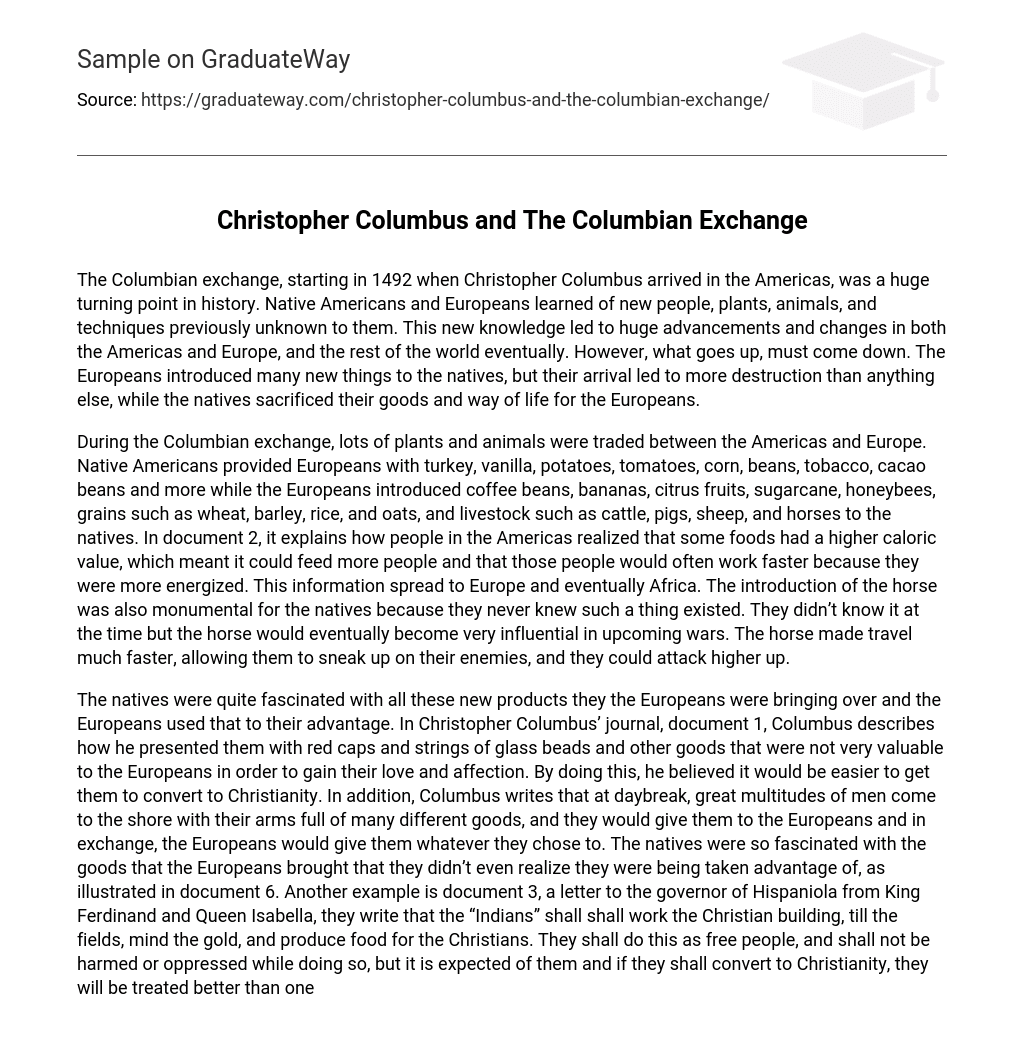The Columbian exchange, starting in 1492 when Christopher Columbus arrived in the Americas, was a huge turning point in history. Native Americans and Europeans learned of new people, plants, animals, and techniques previously unknown to them. This new knowledge led to huge advancements and changes in both the Americas and Europe, and the rest of the world eventually. However, what goes up, must come down. The Europeans introduced many new things to the natives, but their arrival led to more destruction than anything else, while the natives sacrificed their goods and way of life for the Europeans.
During the Columbian exchange, lots of plants and animals were traded between the Americas and Europe. Native Americans provided Europeans with turkey, vanilla, potatoes, tomatoes, corn, beans, tobacco, cacao beans and more while the Europeans introduced coffee beans, bananas, citrus fruits, sugarcane, honeybees, grains such as wheat, barley, rice, and oats, and livestock such as cattle, pigs, sheep, and horses to the natives. In document 2, it explains how people in the Americas realized that some foods had a higher caloric value, which meant it could feed more people and that those people would often work faster because they were more energized. This information spread to Europe and eventually Africa. The introduction of the horse was also monumental for the natives because they never knew such a thing existed. They didn’t know it at the time but the horse would eventually become very influential in upcoming wars. The horse made travel much faster, allowing them to sneak up on their enemies, and they could attack higher up.
The natives were quite fascinated with all these new products they the Europeans were bringing over and the Europeans used that to their advantage. In Christopher Columbus’ journal, document 1, Columbus describes how he presented them with red caps and strings of glass beads and other goods that were not very valuable to the Europeans in order to gain their love and affection. By doing this, he believed it would be easier to get them to convert to Christianity. In addition, Columbus writes that at daybreak, great multitudes of men come to the shore with their arms full of many different goods, and they would give them to the Europeans and in exchange, the Europeans would give them whatever they chose to. The natives were so fascinated with the goods that the Europeans brought that they didn’t even realize they were being taken advantage of, as illustrated in document 6. Another example is document 3, a letter to the governor of Hispaniola from King Ferdinand and Queen Isabella, they write that the “Indians” shall shall work the Christian building, till the fields, mind the gold, and produce food for the Christians. They shall do this as free people, and shall not be harmed or oppressed while doing so, but it is expected of them and if they shall convert to Christianity, they will be treated better than one that does not.
Although the arrival of Europeans was very beneficial to the Americas and the natives living here, there were also some drawbacks. With the arrival of the Europeans came the arrival of diseases that the natives were not used to. Document 7 shows how disease spread from native to native and how quickly it wiped out large amount of the native population.
Looking at the information above, it is safe to say that the Europeans destroyed the natives more than they ever thought possible. Although the spread of diseases wasn’t intentional at first, they ended up using it as a weapon. In addition, they took advantage of the natives’ hospitality and kindness. Although the Europeans introduced some remarkable new things to the natives, they ultimately hurt the natives more than helping them.





